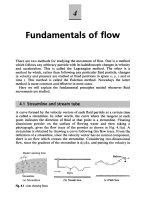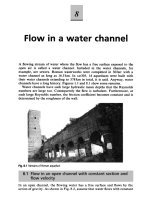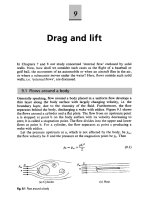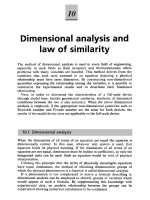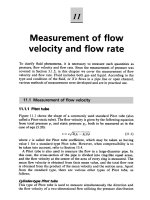Introduction to fluid mechanics - P3
Bạn đang xem bản rút gọn của tài liệu. Xem và tải ngay bản đầy đủ của tài liệu tại đây (1.16 MB, 21 trang )
Fluid statics
Fluid statics is concerned with the balance of forces which stabilise fluids at
rest. In the case of a liquid, as the pressure largely changes according to its
height, it is necessary to take its depth into account. Furthermore, even in the
case of relative rest (e.g. the case where the fluid is stable relative to its vessel
even when the vessel is rotating at high speed), the fluid can be regarded as
being at rest if the fluid movement is observed in terms of coordinates fixed
upon the vessel.
When a uniform pressure acts on a flat plate of area A and a force P pushes
the plate, then
p = P/A
(3.1)
In this case, p is the pressure and P is the pressure force. When the pressure
is not uniform, the pressure acting on the minute area AA is expressed by the
following equation:
3.1.1 Units of pressure
The unit of pressure is the pascal (Pa), but it is also expressed in bars or
metres of water column (mH,O).' The conversion table of pressure units is
given in Table 3.1. In addition, in some cases atmospheric pressure is used:
1atm = 760mmHg(at273.15K,g = 9.80665m/s2) = 101 325Pa
(3.3)
l a t m is standard 1 atmospheric pressure in meteorology and is called the
standard atmospheric pressure.
'
Refer to the spread of 'aqua' at the end of this chapter (p. 37).
Pressure 21
Table 3.1 Conversion of pressure units
Name of unit
Unit
Conversion
Pascal
Bar
Water column metre
Atmospheric pressure
Mercury column metre
Torr
Pa
bar
mH,O
atm
mHg
torr
1 Pa = 1 N/m2
1 bar = 0.1 MPa
1 mH,O = 9 806.65 Pa
1 atm = 101 325Pa
1 mHg = 1/0.76 atm
1 torr = 1mmHg
3.1.2 Absolute pressure and gauge pressure
There are two methods used to express the pressure: one is based on the
perfect vacuum and the other on the atmospheric pressure. The former is
called the absolute pressure and the latter is called the gauge pressure.
Then,
gauge pressure = absolute pressure - atmospheric pressure
In gauge pressure, a pressure under 1 atmospheric pressure is expressed as a
negative pressure. This relation is shown in Fig. 3.1. Most gauges are
constructed to indicate the gauge pressure.
Fig. 3.1 Absolute pressure and gauge pressure
22 Fluid statics
3.1.3 Characteristics of pressure
The pressure has the following three characteristics.
1. The pressure of a fluid always acts perpendicular to the wall in contact
with the fluid.
2. The values of the pressure acting at any point in a fluid at rest are equal
regardless of its direction. Imagine a minute triangular prism of unit width
in a fluid at rest as shown in Fig. 3.2. Let the pressure acting on the small
surfaces dA,, dA, and dA be p,, p2 and p respectively. The following
equations are obtained from the balance of forces in the horizontal and
vertical directions:
pldA, = pdAsin8
p2dA2= pdAcos 8
+ idA,dA,pg
Fig. 3.2 Pressure acting on a minute triangular prism
The weight of the triangle pillar is doubly infinitesimal, so it is omitted.
From geometry, the following equations are obtained:
dA sin 8 = dA,
dA COS 0 = dA,
Therefore, the following relation is obtained:
PI = P 2 = P
(3.4)
Since angle 8 can be given any value, values of the pressure acting at one
point in a fluid at rest are equal regardless of its direction.
3. The fluid pressure applied to a fluid in a closed vessel is transmitted to
all parts at the same pressure value as that applied (Pascal’s law).
In Fig. 3.3, when the small piston of area A, is acted upon by the force
F , , the liquid pressure p = F I / A , is produced and the large piston is acted
upon by the force F, = PA,. Thus
A2
F, = F , A,
(3.5)
Pressure 23
Blaise Pascal (1623-62)
French mathematician, physicist and philosopher. He
had the ability of a highly gifted scientist even in
early life, invented an arithmetic computer at 19
years old and discovered the principle of fluid
mechanics that carries his name. Many units had
appeared as the units of pressure, but it was decided
to use the pascal in SI units in memory of his
achievements.
Fig. 3.3 Hydraulic press
So this device can create the large force F2 from the small force F,. This
is the principle of the hydraulic press.
3.1.4 Pressure of fluid at rest
In general, in a fluid at rest the pressure varies according to the depth.
Consider a minute column in the fluid as shown in Fig. 3.4. Assume that the
sectional area is dA and the pressure acting upward on the bottom surface is
p and the pressure acting downward on the upper surface (dz above the
bottom surface) is p (dp/dz)dz. Then, from the balance of forces acting on
the column, the following equation is obtained:
+
pdAor
( 2 )
p+-dz
dA-pgdAdz=O
24 Fluid statics
Fig. 3.4 Balance of vertical minute cylinder
dp
_ - -PS
&"
(3.6)
Since p is constant for liquid, the following equation ensues:
p = -pg
J
dz = -pgz+C
(3.7)
When the base point is set at zo below the upper surface of liquid as shown
in Fig. 3.5, and po is the pressure acting on that surface, then p = po when
z = zo, so
c = Po + Pgz
Substitutingthis equation into eqn (3.7),
Fig. 3.5 Pressure in liquid
Pressure 25
P = Po
+ (zo - z)Pg = Po + Pgh
(3.8)
Thus it is found that the pressure inside a liquid increases in proportion to
the depth.
For the case of a gas, let us study the relation between the pressure and
the height of the atmosphere surrounding the earth. In this case, since the
density of gas changes with pressure, it is not possible to integrate simply as
in the case of a liquid. As the altitude increases, the temperature decreases.
Assuming this temperature change to be polytropic, then pun = constant is
the defining relationship.
Putting the pressure and density at z = 0 (sea level) as po and Po
respectively, then
P - Po
_-_
(3.9)
P"
Plt
Substituting p into eqn (3.6),
(3.10)
Integrating this equation from z = 0 (sea level),
(3.1 1)
The relation between the height and the atmospheric pressure develops into
the following equation by eqn (3.1 1):
(3.12)
Also, the density is obtained as follows from eqs (3.9) and (3.12):
(3.13)
When the absolute temperatures at sea level and at the point of height z are
T, and T respectively, the following equation is obtained from eqn (2.14):
(3.14)
From eqs (3.12)-(3.14)
(3.15)
From eqn (3.15)
(3.16)
In aeronautics, it has been agreed to make the combined values of
po = 101.325 kPa, T, = 288.15 K and po = 1.225 kg/m3 the standard atmos-
26 Fluid statics
pheric condition at sea level.2 The temperature decreases by 0.65”C every
lOOm of height in the troposphere up to approximately 1 km high, but is
constant at -50.5”C from 1km to lOkm high. For the troposphere, from the
above values for po, & and po in eqn (3.10), n = 1.235 is obtained as the
polytropic index.
3.1.5 Measurement of pressure
Manometer
A device which measures the fluid pressure by the height of a liquid column
is called a manometer. For example, in the case of measuring the pressure of
liquid flowing inside a pipe, the pressure p can be obtained by measuring
the height of liquid H coming upwards into a manometer made to stand
upright as shown in Fig. 3.6(a). When po is the atmospheric pressure and p is
the density, the following equation is obtained:
P=Po+PSH
(3.17)
When the pressure p is large, this is inconvenient because H is too high. So
a U-tube manometer, as shown in Fig. 3.6(b), containing a high-density
liquid such as mercury is used. In this case, when the density is p’,
or
(3.18)
In the case of measuring the air pressure, p’ > p, so p g H in eqn (3.18) may
>
be omitted. In the case of measuring the pressure difference between two
pipes in both of which a liquid of density p flows, a differential manometer as
Fig. 3 6 Manometer
.
*
IS0 2533-1975E.
Pressure 27
Fig. 3.7 Differential manometer (1)
shown in Fig. 3.7 is used. In the case of Fig. 3.7(a), where the differential
pressure of the liquid is small, measurements are made by filling the upper
section of the meter with a liquid whose density is less than that of the liquid
to be measured, or with a gas. Thus
PI - Pz = ( P - p')gH
(3.19)
and in the case where p' is a gas,
PI - Pz = P g H
(3.20)
Figure 3.7(b) shows the case when the differential pressure is large. This
time, a liquid column of a larger density than the measuring fluid is used.
Fig. 3.8 Differential manometer (2)
28 Fluid statics
Fig. 3.9 Inclined manometer
Thus
PI - P2 = (P‘ - P)SH’
(3.21)
and in the case where p is a gas,
PI - P2 = P’SH’
(3.22)
A U-tube manometer as shown in Fig. 3.7 is inconvenient for measuring
fluctuating pressure, because it is necessary to read both the right and left
water levels simultaneously to measure the different pressure. For measuring
the differential pressure, if the sectional area of one tube is made large
enough, as shown in Fig. 3.8, the water column of height H could be
measured by just reading the liquid surface level in the other tube because the
surface fluctuation of liquid in the tank can be ignored.
To measure a minute pressure, a glass tube inclined at an appropriate angle
as shown in Fig. 3.9 is used as an inclined manometer. When the angle of
inclination is a and the movement of the liquid surface level is L, the
differential pressure H i s as shown in the following equation:
H = Lsina
(3.23)
Accordingly, if a is made smaller, the reading of the pressure is magnified.
Besides this, Gottingen-type micromanometer, Chattock tilting micromanometer, etc., are used.
Elastic-type pressure gauge
An elastic-type pressure gauge is a type of pressure gauge which measures
the pressure by balancing the pressure of the fluid with the force of
deformation of an elastic solid. The Bourdon tube (invented by Eugene
Bourdon, 1808-84) (Fig. 3.10), the diaphragm (Fig. 3.1 l), the bellows, etc.,
are widely employed for this type of pressure gauge.
Of these, the Bourdon tube pressure gauge (Bourdon gauge) of Fig. 3.10
is the most widely used in industry. A curved metallic tube of elliptical crosssection (Bourdon tube) is closed at one end which is free to move, but the
other end is rigidly fixed to the frame. When the pressure enters from the
fixed end, the cross-section tends to become circular so the free end moves
outward. By amplifying this movement, the pressure values can be read.
When the pressure becomes less than the atmospheric pressure (vacuum), the
free end moves inward, so this gauge can be used as a vacuum gauge.
Pressure 29
Fig. 3.10 Bourdon tube pressure gauge
Fig. 3.11 Diaphragm pressure gauge
Electric-type pressure gauge
The pressure is converted to the force or displacement passing through the
diaphragm, Bourdon tube bellows, etc., and is detected as a change in an
electrical property using a wire strain gauge, a semiconductor strain gauge
PGM-C
Pressure range (MPa)
Natural frequency (kHz1
Response frequency (kHz1
PE-J, P
(a) Small size
0.2-1 .o
25-40
5-8
(b) For indicating pressure of an engine
5-20
25-40
5-8
Fig. 3.12 Wire strain gauge type of pressure transducer
30 Fluid statics
(applied piezoresistance effect), etc. These types of pressure gauge are useful
for measuring fluctuating pressures. Two examples of pressure gauges
utilising the wire strain gauge are shown in Fig. 3.12.
How large is the force acting on the whole face of a solid wall subject to
water pressure, such as the bank of a dam, the sluice gate of a dam or the wall
of a water tank? How large must the torque be to open the sluice gate of a
dam? What is the force required to tear open a cylindrical vessel subject to
inside pressure? Here, we will study forces like these.
3.2.1 Water pressure acting on a bank or a sluice gate
How large is the total force due to the water pressure acting on a bank built
at an angle 8 to the water surface (Fig. 3.13)? Here, disregarding the
atmospheric pressure, the pressure acting on the surface is zero. The total
pressure d P acting on a minute area dA is pgh dA = pgy sin 8 dA. So, the total
pressure P acting on the under water area of the bank wall A is:
P=
lA
d P = pgsin8
J, ydA
When the centroid3 of A is G, its y coordinate is yG and the depth to G is
hG,SAydA = yGA.So the following equation is obtained:
P = pg sin 8yGA=
(3.24)
Fig. 3.13 Force acting on dam
The centre of mass when the mass is distributed uniformly on the plane of some figure, namely
the point applied to the centre of gravity, is called a centroid.
Forces acting on the vessel of liquid 31
Fig. 3.14 Revolving power acting on water gate (1) (case where revolving axis of water gate is just
on the water level)
So the total force P equals the product of the pressure at the centroid G
and the underwater area of the bank wall.
Next, let us study a rectangular sluice gate as shown in Fig. 3.14. How
large is the torque acting on its turning axis (the x axis)? The force P acting
on the whole plane of the gate is pgy,A by eqn (3.24). The force acting on a
minute area dA (a horizontal strip of the gate face) is pgy dA, the moment of
this force around the x axis is pgydA x y and the total moment on the gate
is f pgy2dA = pg Jy2 dA. Jy2 dA is called the geometrical moment of inertia
I , for the x axis.
Now let us locate the action point of P (i.e. the centre of pressure C) at which
a single force P produces a moment equal to the total sum of the moments
around the turning axis (x axis) of the sluice gate produced by the total water
pressure acting on all points of the gate. When the location of C is y,,
PYC = PSI,
(3.25)
Now, when I , is the geometrical moment of inertia of area for the axis which
is parallel to the x axis and passes through the centroid G, the following
relation exist^:^
I, =I,
+ Ay;
(3.26)
Values of I , for a rectangular plate and for a circular plate are shown in
Fig. 3.15.
Substitute eqn (3.26) into (3.25) to calculate y,
(3.27)
Parallel a x b theorem: The moment of inertia with respect to any axis equals the sum of the
moment of inertia with respect to the axis parallel to this axis which passes through the centroid
and the product of the sectional area and the square of the distance to the centroid from the
former axis.
32 Fluid statics
Fig. 3.15 Geometrical moment of inertia for axis passing centroid G
Fig. 3.16 Rotational force acting on water gate (2) (case where water gate is under water)
From eqn (3.27), it is clear that the action point C of the total pressure P is
located deeper than the centroid G by h2/12yG.
The position of yc in such a case where the sluice gate is located under
the water surface as shown in Fig. 3.16 is given by eqn (3.28) where h, is
substituted for y, in the second term on the right of eqn (3.27):
(3.28)
3.2.2 Force to tear a cylinder
In the case of a thin cylinder where the inside pressure is acting outward, as
shown in Fig. 3.17(a), what kind of force is required to tear this cylinder in
the longitudinal direction? Now, consider the cylinder longitudinally half
sectioned as shown in Fig. 3.17(b), with diameter d, length 1 and inside
pressure p. The force acting on the assumed vertical centre wall ABCD is pdl
which balances the force in the x direction acting outward on the cylinder
wall. In other words, the force generated by the pressure in the x direction on
a curved surface equals the pressure pdl, since the same pressure acts on the
projected area of the curved surface. Furthermore, this force is the force 2T1
Why does a ship float? 33
Fig. 3.17 Cylinder acted on by inertial pressure
( T is the force acting per unit length of wall which tears this cylinder longitudinally in halves along the lines BC and AD):
2T1= pdl
or
T =pd/2
(3.29)
If the tensile stress due to T is lower than the allowable stress, safety is
assured. By utilising this principle, a thin-walled pressure tank can be
designed.
Fluid pressure acts all over the wetted surface of a body floating in a fluid,
and the resultant pressure acts in a vertical upward direction. This force is
called buoyancy. The buoyancy of air is small compared with the gravitational force of the immersed body, so it is normally ignored.
Fig. 3.18 Cube in liquid
34 Fluid statics
Archimedes (287-212~3
The greatest mathematician, physicist and
engineer in ancient Greece, and the discoverer of
the famous ‘Principle of Archimedes‘. Archimedes
received guidance in astronomy from his father,
an astronomer, and made astronomical observations since his early days. He invented a
planetarium turned by hydropower and a screw
pump. He carried out research in solid and fluid
dynamics as well as on the lever, the centre of
gravity and buoyancy. Archimedes was one of
those scientists who are talented in both theory
and practice.
Suppose that a cube is located in a liquid of density p as shown in
Fig. 3.18. The pressure acting on the cube due to the liquid in the horizontal
direction is balanced right and left. For the vertical direction, where the
atmospheric pressure is po, the force Fl acting on the upper surface A is
expressed by the following equation:
4
= (Po
+ PSh1)A
(3.30)
The force F2 acting on the lower surface is
F
2
= (Po
+ P9hz)A
(3.31)
So, when the volume of the body in the liquid is V, the resultant force F from
the pressure acting on the whole surface of the body is
F = F* - Fl = pg(h, - h,)A = pghA = p g v
(3.32)
The same applies to the case where a cube is floating as shown in Fig.
3.18(b). From this equation, the body in the liquid experiences a buoyancy
equal to the weight of the liquid displaced by the body. This result is known
as Archimedes’ principle. The centre of gravity of the displaced liquid is
called ‘centre of buoyancy’ and is the point of action of the buoyancy force.
Next, let us study the stability of a ship. Figure 3.19 shows a ship of
weight W floating in the water with an inclination of small angle 8. The
location of the centroid G does not change with the inclination of the ship.
But since the centre of buoyancy C moves to the new point C’, a couple of
forces Ws = Fs is produced and this couple restores the ship’s position to
stability.
The forces of the couple Ws are called restoring forces. The intersecting
point M on the vertical line passing through the centre of buoyancy C’ (action
line of the buoyancy F) and the centre line of the ship is called the
Relatively stationary state 35
Fig. 3.19 Stability of a ship
metacentre, and GM is called the metacentric height.5 As shown in the figure,
if M is located higher than G, the restoring force acts to stabilise the ship,
but if M is located lower than G, the couple of forces acts to increase the roll
of the ship and so make the ship unstable.
When a vessel containing a liquid moves in a straight line or rotates, if there
is no relative flow of the liquid while the vessel and liquid move as a body,
it is possible to treat this as the mechanics of a stationary state. This state is
called a relatively stationary state.
3.4.1 Equiaccelerated straight-line motion
Suppose that a vessel filled with liquid is moving in a straight line at constant
acceleration on the horizontal level as shown in Fig. 3.20. Further consider a
minute element of mass m on the liquid surface, where its acceleration is CY,the
Fig. 3.20 Uniform accelerating straight-line motion
How high is the metacentre of a real ship? It is said that the height of metacentre of a warship
is about 0.8-1.2 m, a sailing ship 1 .O-1.4 m and a large passenger ship 0.3-0.7 m. When these
ships go out to sea the wave cycle is 12-13 seconds.
5
36 Fluid statics
forces acting on m are gravity in a vertical downward direction -mg, and the
inertial force in the reverse direction to the direction of acceleration -ma.
There can be no force component normal to the direction of F, the
resultant force of gravity and the inertial forces. Therefore, the pressure must
be constant on the plane normal to the direction of F. In other words, this
plane identifies the equipressure free surface.
When 8 is the angle formed by the free surface and the x direction, the
following relation is easily obtained:
tan 8 = a / g
(3.33)
If h is the depth measured in the vertical direction to the free surface, the
acceleration in this direction is /? = F / m . Therefore,
P = PBh
(3.34)
This is the same relation as the stationary state.
3.4.2 Rotational motion
Let us study the height of the water surface in the case where a cylindrical
vessel filled with liquid is rotating at constant angular velocity o. The
movement at constant angular velocity like this is sometimes called
gyrostatics, where the liquid surface poses a concave free surface. Then let
us take cylindrical coordinates (r,O,z) as shown in Fig. 3.21. Consider a
minute element of mass m on the equipressure plane. The forces acting on
it are -mg due to the gravitational acceleration g in the vertical direction
and -mro2 due to the centripetal acceleration rw2 in the horizontal
direction.
Fig. 3.21 Rotational motion around vertical axis
Relatively stationary state 37
Since the vessel and liquid move in a body and the liquid stays in a
relatively stationary state, the resultant force F is vertical to the free surface
as in the previous case. If 4 is the angle formed by the free surface and the
horizontal direction,
tan4=-
mrwL- rwL
--
mg
but also
Therefore,
9
(3.35)
dz
tan4 =dr
Putting c as a constant of integration,
0
z=-r 2 + c
(3.36)
29
If z = h, at r = 0, c = h, and the following equation is obtained from eqn
(3.36):
w2r2
(3.37)
z-ho=2y
The free surface is now a rotating parabolic surface.
Spread of aqua
Aqua means water in Sanskrit, especially water offered to Buddha. The Italian
word for water is aqua, and the Spanish is agua, both of which have the same
etymological origin. Also, ‘aqualung’ is diving gear meaning water lung.
The Japanese word aka appeared in Japanese classics in the tenth, eleventh
and thirteenth centuries. Furthermore, aka also means bilge water.
It is very interesting to know that Sanskrit aqua spread from India to
Europe along the Silk Road and to Japan via China.
38 Fluid statics
1. What is the water pressure on the sea bottom at a depth of 6500m? The
specific gravity of sea water is assumed to be 1.03.
2. Obtain the pressure p at point A in Figs 3.22(a), (b) and (c).
Fig. 3.22
3. Obtain the pressure difference p , - p2 in Figs 3.23(a) and (b).
Fig. 3.23
4. On the inclined manometer in Fig. 3.24, whenever h changes by 1 mm,
how high (in mm) is H? (Sectional area A = lOOa and CY = 30°.)
Fig. 3.24
Problems 39
5. In the case shown in Fig. 3.25, an oblong board 3 m high and 5m wide
is placed vertically in water in such a manner that its upper face is 5 m
deep. Obtain the force acting on this board and the location of the centre
of pressure.
6. What are the respective forces F acting on the lower stays of the water
gates in Figs 3.14 and 3.16, provided that the height b of the water gate is
3 m, the width is 1m, and h, in Fig. 3.16 is 2m?
7. A water gate 2 m high and 1 m wide is shown in Fig. 3.26. What is the
force acting on the lower stay?
8. What is the force acting on a unit width of the dam wall shown in
Fig. 3.27, if the water is 15m deep and the wall is inclined at 60°?
Furthermore, how far along the wall from the water surface is the action
point of the force?
Fig. 3.25
Fig. 3.26
Fig. 3.27
9. As shown in Fig. 3.28, a circular water gate, diameter 2m, is supported
by a horizontal shaft. What is the moment around the shaft to keep the
water gate closed?
10. A circular segment water gate, 5 m long, is set as shown in Fig. 3.29. Water
is stored up to the upper face of the water gate. Obtain the magnitudes of
the horizontal and vertical components of force and also the magnitude
and the direction of the resultant force acting on this water gate.
Fig. 3.28
Fig. 3.29
40 Fluid statics
11. An iceberg of specific gravity 0.92 is floating on the sea with a specific
gravity of 1.025. If the volume of the iceberg above the water level is
loom3,what is the total volume of the iceberg?
12. As shown in Fig. 3.30 a body of specific gravity 0.8 is floating on the
water. Obtain the height of its metacentre and the period of vibration
whenever its side A is perturbed.6 The effect of the additional mass of
water can be omitted.
Fig. 3.30
13. A cylindrical vessel of radius ro filled with water to height h is rotated
around the central axis, and the difference in height of water level is
h'. What is the rotational angular velocity? Furthermore, assuming
r, = lOcm and h = 18cm, obtain o when h' = lOcm and also the
number of revolutions per minute n when the cylinder bottom begins
to appear.
6
If h is the height of the metacentre, V the displacement volume, I the sectional secondary
moment around the centre line of the water plane, and e the height from the centre of buoyancy
to the centre of gravity, then
h = ( I / V )- e
If J is the moment of inertia around the longitudinal axis passing through the centre of gravity,
tJ the inclination angle and m the mass, the movement equation for crosswise vibration is
(whenever 0 is small), then
d2tJ
= -mghtJ
d$
the turning radius around the centre of gravity, then
k
T =2 ~ J-
If T is the period, k =
m
m


